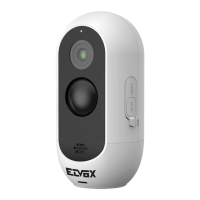Telecamere Wi-Fi
5
IT
EN
Raccomandazioni d’uso
Queste telecamere, sono dispositivi che utilizzano la trasmissione video su
segnale WiFi.
Eventuali fattori che inuiscono sulla trasmissione del segnale Wi-Fi possono
causare una cattiva esperienza nell‘uso del prodotto. Pertanto, durante
l‘installazione e l‘utilizzo, si raccomanda di seguire i seguenti consigli per ottenere
la migliore esperienza possibile con il prodotto.
Recommendations for use
These cameras, are devices that uses video transmission on a Wi-Fi signal.
Any factors aecting the transmission of the Wi-Fi signal may cause a negative
experience when using the product. Therefore, during installation and use, it is
recommended to follow these instructions to ensure the best possible experience
with the product.
1.3 - Suggerimenti per il posizionamento del Router domestico
1. Verificare la potenza del segnale WiFi delle telecamere nel menu
"Informazioni dispositivo" nell' app Wiew Product.
Assicurarsi che le telecamere abbiano almeno potenza>60% nell’area in cui
si desidera posizionarle. Le telecamere riuscirebbero a funzionare anche
con una potenza inferiore, ma potrebbero disconnettersi frequentemente
dalla rete.
2. Se la potenza del segnale risultasse scarsa, ciò potrebbe essere dovuto al
router posizionato troppo lontano dalla telecamera o da ostacoli presenti
nell’ambiente.
3. Se possibile, provare ad avvicinare la telecamera al router scegliendo
un’altra posizione.
4. Ottimizzare la posizione del router, posizionandolo preferibilmente al centro
dell’impianto e il più possibile lontano dal suolo o dal pavimento (almeno
50cm).
Ostacoli che inuiscono negativamente sul segnale WiFi
Gli ostacoli che inuenzano negativamente la trasmissione del segnale WiFi
sono quelli interposti sulla linea immaginaria che unisce l’antenna del router con
l’antenna della telecamera.
Per tale motivo la posizione della telecamera è molto importante e determinante
per aggirare gli ostacoli.
La portata del segnale è ridotta da qualsiasi parete, sotto o altri ostacoli di grandi
dimensioni interposti tra la telecamera e il router.
Ostacoli metallici
L’unico materiale, capace di impedire il passaggio del segnale radio è il metallo. È
importante prestare particolare attenzione a cancelli metallici di grosse dimensioni,
ringhiere o alle scaalature metalliche. Non installare le telecamere all’interno di
“gabbie” metalliche.
Ostacoli non metallici
Gli ostacoli non metallici non hanno un vero eetto schermante e consentono
sempre il passaggio del segnale, tuttavia, introducono una certa attenuazione.
Gli ostacoli con maggiore densità e spessore, come i muri spessi in cemento o le
solette dei sotti, introducono un’attenuazione superiore a materiali meno densi
e in genere più sottili come legno, plastica etc.
Posizionare la telecamera
Tanto più gli ostacoli sono vicini al trasmettitore (telecamera) tanto più deteriorano
la trasmissione.
Installare la telecamera in un luogo il più possibile aperto verso il router in modo
da non avere ostacoli importanti nei primi metri di percorso.
Le altezze delle telecamere non devono necessariamente essere identiche, tuttavia
un fattore chiave è che l’installazione non dovrebbe essere inferiore a 1,8 metri
dal suolo o dal pavimento.
1.3 - Suggestions for positioning the Home Router
1. Check the WiFi signal strength of the cameras in the "Device Information"
menu in the View Product app.
Make sure the cameras have at least >60% signal power in the area where
you want to place them. The cameras would be able to work even with
lower signal strength, but may frequently disconnect from the network.
2. If the signal power is low, this maybe due to the router being positioned too
far away from the camera or to obstacles in the area.
3. If possible, try to move the camera closer to the router in another position.
4. Optimise the router position, preferably in the centre of the system and as
far as possible from the ground or oor (at least 50 cm).
Obstacles negatively aecting the WiFi signal
Obstacles negatively aecting the transmission of the WiFi signal are those
positioned along the imaginary line between the router antenna and the camera
antenna.
For this reason, the camera position is very important and decisive for overcoming
any obstacles.
The signal range is reduced by any walls, ceilings or other large obstacles placed
between the camera and the router.
Metallic obstacles
The only material that can prevent the passage of the radio signal is metal. It is
important to pay close attention to large metal gates, railings or metal shelving.
Do not install the cameras inside metal “cages”.
Non-metallic obstacles
Non-metallic obstacles do not have a fully shielding eect and in any case allow the
signal to pass, however they may reduce the signal. Obstacles with high density
and thickness, like thick concrete walls or ceilings, reduce the signal more than
less dense and generally thinner materials such as wood, plastic, etc.
Position the camera
The closer the obstacles are to the transmitter (camera) the weaker the
transmission.
Install the camera in a space that is as open as possible, facing the router, avoiding
major obstacles in the rst few metres of its path.
The camera heights do not need to be identical, but one key factor is that they
should not be installed at a height of less than 1.8 metres o the ground or oor.

